-
(单词翻译:双击或拖选)
VOICE ONE:
I’m Phoebe Zimmerman.
VOICE TWO:
And I’m Steve Ember with the VOA Special English program People in America. Today we tell about the life and work of the greatest American building designer of the twentieth century, Frank Lloyd Wright.
(MUSIC)
VOICE ONE:
Frank Lloyd Wright designed buildings for more than seventy years. He did most of his
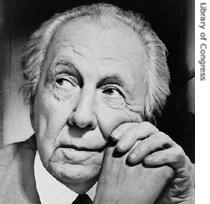 |
| Frank Lloyd Wright |
Critics say Frank Lloyd Wright was one of America's most creative architects. One critic said his ideas were fifty years ahead of the time in which he lived.
(MUSIC)
VOICE TWO:
Frank Lloyd Wright was born in eighteen sixty‑seven in the middle western state of Wisconsin. He studied engineering at the University of Wisconsin. In eighteen eighty‑seven, he went to the city of Chicago. He got a job in the office of the famous architects, Louis Sullivan and Dankmar Adler.
Several years later, Wright established his own building design business. He began by designing homes for people living in and near Chicago. These homes were called "prairie houses."
VOICE ONE:
Prairie houses were long and low. They seemed to grow out of the ground. They were built of wood and other natural materials. The indoors expanded to the outdoors by extending the floor. This created what seemed like a room without walls or a roof.
In nineteen-oh-two, Wright designed one prairie house, called the Willits House, in the town of Highland1 Park. The house was shaped like a cross. It was built around a huge fireplace2. The rooms were designed so they seemed to flow into each other.
VOICE TWO:
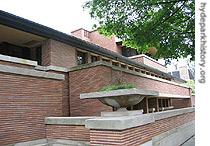 |
| Robie House |
Wright's prairie houses had a great influence on home design in America. Even today, one hundred years later, his prairie houses appear very modern.
VOICE ONE:
In the nineteen thirties, Wright developed what he called "Usonian" houses. Usonia was his name for a perfect, democratic United States of America. Usonian houses were planned to be low cost. Wright designed them for the American middle class. These are the majority of Americans who are neither very rich nor very poor.
Frank Lloyd Wright believed that all middle class families in America should be able to own a house that was designed well. He believed that the United States could not be a true democracy if people did not own their own house on their own piece of land.
VOICE TWO:
Usonian houses were built on a flat base of concrete. The base was level with the ground. Wright believed that was better and less costly3 than the common method of digging a hole in the ground for the base. Low‑cost houses based on the Usonian idea became very popular in America in the nineteen fifties. Visitors can see one of Wright's Usonian homes near Washington, D. C. It is the Pope-Leighy House in Alexandria, Virginia.
(MUSIC)
VOICE ONE:
Frank Lloyd Wright believed in spreading his ideas to young building designers. In nineteen thirty‑two, he established a school called the Taliesin Fellowship4. Architectural students paid to live and work with him.
During the summer, they worked at his home near Spring Green, Wisconsin. Wright called this house "Taliesin." That is a Welsh name meaning "shining brow." It was built of stone and wood into the top of a hill.
During the winter, they worked at Taliesin West. This was Wright’s home and architecture office near Phoenix5, Arizona. Wright and his students started building it in nineteen thirty-seven in the Sonoran Desert.
VOICE TWO:
Taliesin West is an example of Frank Lloyd Wright’s ideas of organic architecture taking
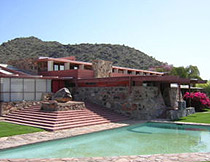 |
| Taliesin West |
Frank Lloyd Wright had discovered the beauty of the desert in nineteen twenty-seven when he was asked to help with the design of the Arizona Biltmore hotel. He continued to return to the desert with his students to escape the harsh6 winters in Wisconsin.
Ten years later he found a perfect place for his winter home and school. He bought about three hundred hectares of desert land at the foot of the McDowell Mountains near Scottsdale, Arizona.
Wright said: ‿I was struck by the beauty of the desert, by the dry, clear sun-filled air, by the stark7 geometry of the mountains.‿nbsp; He wanted everyone who visited Taliesin West to feel this same sense of place.
VOICE ONE:
His architecture students helped him gather rocks and sand from the desert floor to use as building materials. They began a series of buildings that became home, office and school. Wright kept working on and changing what he called a building made of many buildings for twenty years.
Today, Taliesin West has many low stone buildings linked together by walkways and courtyards. It is still very much alive with activity. About seventy people live, work and study there. Guides take visitors through what is one of America’s most important cultural treasures.
VOICE TWO:
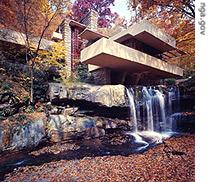 |
| Falling Water |
"Fallingwater" is so unusual and so beautiful that it came to represent modern American architecture. One critic calls it the greatest house of the twentieth century. Like Taliesin West, "Fallingwater" is open to the public.
VOICE ONE:
Frank Lloyd Wright also is famous for designing imaginative8 public buildings. In nineteen‑oh‑four, he designed an office building for the Larkin Soap Company in Buffalo9, New York. The offices were organized around a tall open space. At the top was a glass roof to let sunlight into the center.
In the late nineteen thirties, Wright designed an office building for the Johnson Wax Company in Racine, Wisconsin. It also had one great room without traditional walls or windows. The outside of the building was made of smooth, curved brick and glass.
(MUSIC)
VOICE TWO:
In nineteen forty‑three, Frank Lloyd Wright designed one of his most famous projects: the Guggenheim Museum of Art in New York City. The building was completed in nineteen sixty, the year following his death.
The Guggenheim is unusual because it is a circle. Inside the museum, a walkway rises
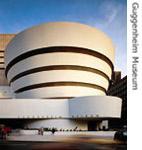 |
| The Guggenheim Museum in New York |
The Guggenheim museum was very different from Wright's other designs. It even violated10 one of his own rules of design: the Guggenheim's shape is completely different from any of the buildings around it.
VOICE ONE:
When Wright was a very old man, he designed the Marin County Civic11 Center in San Rafael, California, near San Francisco. The Civic Center project was one of his most imaginative designs. It is a series of long buildings between two hills.
Frank Lloyd Wright believed that architecture is life itself taking form. “Therefore,‿he said, “it is the truest record of life as it was lived in the world yesterday, as it is lived today, or ever will be lived.‿
Frank Lloyd Wright died in nineteen fifty-nine, in Phoenix, Arizona. He was ninety‑one years old. His buildings remain a record of the best of American Twentieth Century culture.
(MUSIC)
VOICE TWO:
This Special English program was written by Shelley Gollust and Marilyn Christiano. It was produced by Lawan Davis. Our studio engineer was Max Carroll. I’m Steve Ember.
VOICE ONE:
And I’m Phoebe Zimmerman. Join us again next week for another People in America program on the Voice of America.
 收听单词发音
收听单词发音
1
highland

|
|
| n.(pl.)高地,山地 | |
参考例句: |
|
|
|
2
fireplace

|
|
| n.壁炉,炉灶 | |
参考例句: |
|
|
|
3
costly

|
|
| adj.昂贵的,价值高的,豪华的 | |
参考例句: |
|
|
|
4
fellowship

|
|
| n.伙伴关系,团体,奖学金,研究员职位 | |
参考例句: |
|
|
|
5
phoenix

|
|
| n.凤凰,长生(不死)鸟;引申为重生 | |
参考例句: |
|
|
|
6
harsh

|
|
| adj.严厉(酷)的,刺耳的,刺目的,毛糙的 | |
参考例句: |
|
|
|
7
stark

|
|
| adj.荒凉的;严酷的;完全的;adv.完全地 | |
参考例句: |
|
|
|
8
imaginative

|
|
| adj.富有想象力的,爱想象的 | |
参考例句: |
|
|
|
9
buffalo

|
|
| n.(北美)野牛;(亚洲)水牛 | |
参考例句: |
|
|
|
10
violated

|
|
| 亵渎( violate的过去式和过去分词 ); 违反; 侵犯; 强奸 | |
参考例句: |
|
|
|
11
civic

|
|
| adj.城市的,都市的,市民的,公民的 | |
参考例句: |
|
|
|















